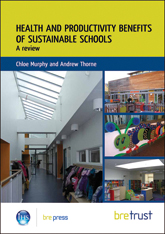
by Brianna Crandall — September 27, 2010—BRE has announced the publication of a new report, Health and Productivity Benefits of Sustainable Schools, which reviews evidence from international research that the environmental design of schools has a positive effect on teaching and learning.
The report, published by IHS BRE Press, reviews more than 70 documents comprising authoritative international research papers, legislative requirements, best-practice guidance, and reference standards, and explores the potential benefits of: access to fresh air, daylight, and views to the outside; acoustic performance; thermal comfort; and the size and layout of teaching and learning spaces.
“Research has shown that ‘green’ schools provide healthier and more productive environments because many of the features of green buildings, including daylight, fresh air, materials with low pollutants, etc., correlate strongly with factors known to contribute to health and well-being,” said Chloe Murphy, who, along with Andrew Thorne, authored the review.
The report also said studies show pupils perform better in acoustically treated rooms where background noise and reverberation times are reduced, because excessive noise levels can be a distraction. Murphy noted that temperatures and space allocations for students also impact alertness and behavior in the classroom.
With large numbers of students in education and major investment in school buildings, the environmental and economic benefits of improving health and productivity in schools through environmental measures are potentially enormous, says BRE. In England alone, there are approximately 24,000 schools providing education for about 7.5 million students each year, with an annual carbon footprint of 10 million tons, accounting for 15 percent of public-sector carbon emissions.




